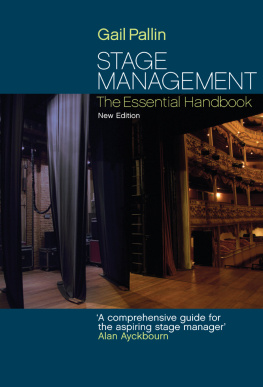I could never have written this book without the forbearance of my family and friends, and my colleagues and students at the Central School of Speech and Drama. Their tolerant support through some difficult times has enabled this endeavour to come to fruition.
I would like to thank all the stage managers, production managers, technicians, directors, designers, performers and so forth who have taught me so much about the art of stage management.
In particular I would like to thank the following people for their help and input: David Adams, David Ayliff, Howard Bird, Daniel Bond, Tracy Cattell, Barbara Eifler, Cindy Limauro, Alastair Noonan, Keith Orton, Gail Pallin, Christine Schott, Conrad Schwartz and Jessica Turnpenny.
The Model Technical Rider (.
The Code of Practice for Health and Safety Demonstrations for Performers and Stage Management () is reproduced with the consent of the Theatre Safety Committee, a cross-industry body which monitors developments and disseminates information relating to health and safety in the theatre industry. Management organisations, unions and other industry bodies with an interest in health and safety are represented on the committee.
Four Steps to Risk Assessment () is adapted from free guidelines issued by the Health and Safety Committee (HSC).
Permission to reproduce material from the following publications is also gratefully acknowledged: Steven Covey, The Seven Habits of Highly Effective People, published by Simon and Schuster, 1999, courtesy of FranklinCovey Co, Salt Lake City, Utah, USA; Judith Taylor, Communication at Work, published by Kogan Page Ltd, 2001; Alan Barker, How to Manage Meetings, published by Kogan Page Ltd, 2002.
Finally I would like to thank my wife for putting up with me and teaching me everything I needed to know about actors but was afraid to ask!
Peter Maccoy, July 2004
Besides the Health and Safety at Work Act itself, the following apply across the full range of workplaces:
1. Management of Health and Safety at Work Regulations 1992: require employers to carry out risk assessments, make arrangements to implement necessary measures, appoint competent people and arrange for appropriate information and training.
2. Workplace (Health, Safety and Welfare) Regulations 1992: cover a wide range of basic health, safety and welfare issues such as ventilation, heating, lighting, workstations, seating and welfare facilities.
3. Health and Safety (Display Screen Equipment) Regulations 1992: set out requirements for work with visual display units (VDUs).
4. Personal Protective Equipment (PPE) Regulations 1992: require employers to provide appropriate protective clothing and equipment for their employees.
5. Provision and Use of Work Equipment Regulations (PUWER) 1992: require that equipment provided for use at work, including machinery, is safe.
6. Manual Handling Operations Regulations 1992: cover the moving of objects by hand or physical effort.
7. Health and Safety (First Aid) Regulations 1981: cover requirements for first aid.
8. Health and Safety Information for Employees Regulations 1989: require employers to display a poster telling employees what they need to know about health and safety.
9. Employers Liability (Compulsory Insurance) Regulations 1969: require employers to take out insurance against accidents and ill-health to their employees.
10. Reporting of Injuries, Diseases and Dangerous Occurrences Regulations 1985 (RIDDOR): require employers to notify certain occupational injuries, diseases and dangerous events.
11. Noise at Work Regulations 1989: require employers to take action to protect employees from hearing damage.
12. Electricity at Work Regulations 1989: require people in control of electrical systems to ensure they are safe to use and maintained in a safe condition.
13. Control of Substances Hazardous to Health Regulations 1994 (COSHH): require employers to assess the risks from hazardous substances and take appropriate precautions.
In addition, specific regulations cover particular areas, for example asbestos and lead:
1. Chemicals (Hazard Information and Packaging for Supply) Regulations (CHIP 2) 1994: require suppliers to classify, label and package dangerous chemicals and provide safety data sheets for them.
2. Construction (Design and Management) Regulations 1994: cover safe systems of work on construction sites.
3. Gas Safety (Installation and Use) Regulations 1994: cover safe installation, maintenance and use of gas systems and appliances in domestic and commercial premises.
Reproduced courtesy of the Theatre Safety Committee. The Theatre Safety Committee is a cross-industry body which monitors developments and disseminates information relating to health and safety in the theatre industry.
Procedures relating to health and safety vary considerably both in theatres and in opera houses. It is the aim of this code of practice to establish best practice in the industry, to improve communication and ultimately to reduce accidents and near-misses.
1. Risk assessment documentation should be made available to performers, if requested, before the first rehearsal on the stage set.
2. There should be a health and safety demonstration of the set by a technical representative of the management at the first rehearsal on the stage set, be that in the rehearsal studio or on stage, before any rehearsal activity takes place. All performers and stage management should attend and, at the conclusion of the demonstration, should be asked to identify any concerns they may have either individually or collectively.
3. If there are any changes to the set between the rehearsal studio and the first rehearsal on stage on the set, then a further health and safety demonstration should take place, as detailed above, before any work using the set gets under way.
4. There should be a further health and safety demonstration of the set when the performers are in costume.
5. Such demonstrations will form part of scheduled working time.
6. If the show transfers from one theatre to another and there is a substantive change to the set between the final performance in one venue and the next, a further health and safety demonstration should take place before the first rehearsal or performance using the set.
7. In the event of any change of performers, any newcomers should witness a health and safety demonstration before they first use the set.
8. Should a performer be required to work on a steeply raked stage (one that is 1 in 12 or steeper), the Manager should provide an appropriately qualified individual to demonstrate how to work safely and without longterm injury on a raked surface and to provide such continued supervision and support as is considered appropriate by the qualified individual.
Safety is the prime concern of all members of a theatres staff, both backstage and front of house. When an audience is present in a theatre space, it is the responsibility of the theatre to ensure their safety. For this reason it is important that all members of staff are aware of the procedures associated with the discovery of a fire, or any other potential hazard such as a bomb threat, which might result in the evacuation of the building.
The cardinal rule in dealing with such situations is not to cause panic, which may result in a greater danger to the audience than the original threat.
The words BOMB or FIRE must NEVER be used in the hearing of the public, and it is better not to use them at all. These words are bound to spread alarm and panic if heard by a member of an audience.










